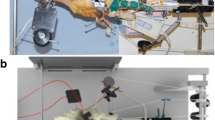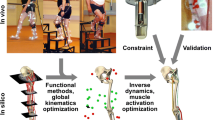Abstract
Purpose
The menisci are thought to modulate load transfer and to absorb shocks in the knee joint. No study has experimentally measured the meniscal functions in the intact, in vivo joint loaded by physiologically relevant muscular contractions.
Methods
Right knee joints of seven New Zealand white rabbits were loaded using isometric contractions of the quadriceps femoris muscles controlled by femoral nerve stimulation. Isometric knee extensor torques at the maximal and two submaximal force levels were performed at knee angles of 70°, 90°, 110°, and 130°. Patellofemoral and tibiofemoral contact areas and pressure distributions were measured using Fuji Presensor film inserted above and below the menisci and also with the menisci removed.
Results
Meniscectomy was associated with a decrease in tibiofemoral contact area ranging from 30 to 70 % and a corresponding increase in average contact pressures. Contact areas measured below the menisci were consistently larger than those measured on top of the menisci. Contact areas in the patellofemoral joint (PFJ), and peak pressures in tibiofemoral and PFJs, were not affected by meniscectomy. Contact areas and peak pressures in all joints depended crucially on knee joint angle and quadriceps force: The more flexed the knee joint was, the larger were the contact areas and the higher were the peak pressures.
Conclusions
In agreement with the literature, removal of the menisci was associated with significant decreases in tibiofemoral contact area and corresponding increases in average contact pressures, but surprisingly, peak pressures remained unaffected, indicating that the function of the menisci is to distribute loads across a greater contact area.





Similar content being viewed by others
References
Aagard H, Verdonk R (1999) Function of the normal meniscus and consequences of meniscal resection. Scand J Med Sci Sports 9:134–140
Allaire R, Muriuku M, Gilbertson L, Harner CD (2008) Biomechanical consequences of a tear of the posterior root of the medial meniscus. J Bone Joint Surg Am 90:1922–1931
Baratz ME, Fu FH, Mengato R (1986) Meniscal tears: the effect of meniscectomy and of repair on intraarticular contact areas and stress in the human knee. Am J Sports Med 14:270–275
Bedi A, Kelly NH, Baad M, Fox AJS, Brophy RH, Warren RF, Maher SA (2010) Dynamic contact mechanics of the medial meniscus as a function of radial tear, repair, and partial meniscectomy. J Bone Joint Surg Am 92:1398–1408
Butterfield TA, Herzog W (2005) Is the force-length relationship a useful indicator of contractile element damage following eccentric exercise? J Biomech 38:1932–1937
Clark AL, Herzog W, Leonard TR (2002) Contact area and pressure distribution in the feline patellofemoral joint under physiologically meaningful loading conditions. J Biomech 35:53–60
Fukubayashi T, Kurosawa T (1980) The contact area and pressure distribution pattern of the knee. A study of normal and osteoarthritic knee joints. Acta Orthop Scand 51:871–879
Grover DM, Chen AA, Hazelwood SJ (2007) Biomechanics of the rabbit knee and ankle: muscle, ligament, and joint contact force predictions. J Biomech 40:2816–2821
Gushue D, Houck J, Lerner AL (2005) Rabbit knee joint biomechanics: motion analysis and modeling of forces during hopping. J Orthop Res 23:735–742
Isaac DI, Meyer EG, Haut RC (2010) Development of a traumatic anterior cruciate ligament and meniscal rupture model with a pilot in vivo study. J Biomech Eng 132:464–501
Kääb MJ, Ito K, Clark JM, Nötzli HP (2000) The acute structural changes of loaded articular cartilage following meniscectomy or ACL-transection. Osteoarthritis Cartilage 8:464–473
Kim JG, Lee YS, Bae TS, Ha JK, Lee DH, Kim YJ, Ra HJ (2013) Tibiofemoral contact mechanics following posterior root of medial meniscus tear, repair, meniscectomy, and allograft transplantation. Knee Surg Sports Traumatol Arthrosc 21:2121–2125
Kurosawa H, Fukubayashi T, Nakajima HL (1980) Load-bearing mode of the knee joint: physical behaviour of the knee joint with or without menisci. Clin Orthop Relat Res 149:283–290
Leumann A, Fortuna R, Leonard T, Valderrabano V, Herzog W (2013) Dynamic in vivo force transfer in the lapine knee loaded by quadriceps muscle contraction. Clin Biomech 28:199–204
Liggins AB, Hardie WR, Finlay JB (1994) Sterilization of Fuji pressure-sensitive film. Med Eng Phys 16:496–500
Longino D, Frank C, Leonard TR, Vaz MA, Herzog W (2005) Proposed model of botulinum toxin-induced muscle weakness in the rabbit. J Orthop Res 23:1411–1418
Maas H, Baan G, Huijing P (2004) Muscle force is determined also by muscle relative position: isolated effects. J Biomech 37:99–110
Martens T, Hull M, Howell S (1997) An in vitro osteotomy method to expose the medial compartment of the human knee. J Biomech Eng 119:379–385
McDermott ID, Amis AA (2006) The consequences of meniscectomy. J Bone Joint Br 68:1549–1556
McDermott ID, Masouros SD, Amis AA (2008) Biomechanics of the menisci of the knee. Curr Orthop 22:193–201
Messner K, Fahlgren A, Persliden J, Andersson BM (2001) Radiographic joint space narrowing and histologic changes in a rabbit meniscectomy model of early knee osteoarthrosis. Am J Sports Med 29:151–160
Ode GE, Van Thiel GS, McArthur SA, Dishkin-Paset J, Leurgans SE, Shewman EF, Wang VM, Cole BJ (2012) Effects of serial sectioning and repair of radial tears in the lateral meniscus. Am J Sports Med 40:1863–1872
Paletta GA, Manning T, Snell E, Parker R (1997) The effect of allograft meniscal replacement on intraarticular contact area and pressures in the human knee. A biomechanical study. Am J Sports Med 25:692–698
Petty CA, Lubowitz JH (2011) Does arthroscopic partial meniscectomy result in knee osteoarthritis? A systematic review. Arthroscopy 27:419–424
Proffen BL, McElfresh M, Fleming BC, Murray MM (2012) A comparative anatomical study of the human knee and six animal species. Knee 19:493–499
Pozzi A, Tonks CA, Ling HY (2010) Femorotibial contact mechanics and meniscal strain after serial meniscectomy. Vet Surg 39:482–488
Rehan Youssef A, Longino D, Seerattan R, Leonard T, Herzog W (2009) Muscle weakness causes joint degeneration in rabbits. Osteoarthritis Cartilage 17:1228–1235
Roemhildt ML, Coughlin KM, Peura GD, Badger GJ, Churchill D, Fleming BC, Beynnon BD (2010) Effects of increased chronic loading on articular cartilage material properties in the Lapine tibio-femoral joint. J Biomech 43:2301–2308
Ronsky JL, Herzog W, Brown TD, Pedersen DR, Grood RS, Butler DL (1995) In vivo quantification of the cat patellofemoral joint contact stresses and areas. J Biomech 28:977–983
Roos EM, Ostenberg A, Roos H, Ekdahl C, Lohmander LS (2001) Long-term outcome of meniscetomy: symptoms, function, and performance tests in patients with or without radiographic osteoarthritis compared to matched controls. Osteoarthritis Cartilage 9:316–324
Roos H, Lauren M, Adalberth T, Roos EM, Jonsson K, Lohmander LS (1998) Knee osteoarthritis after meniscectomy: prevalence of radiographic changes after twenty-one years, compared with matched controls. Arthritis Rheum 41:687–693
Sawatsky A, Bourne D, Horisberger M, Jinha A, Herzog W (2012) Changes in patellofemoral joint contact pressures caused by vastus medialis muscle weakness. Clin Biomech 27:595–601
Shirazi R, Shirazi-Adl A (2009) Analysis of partial meniscectomy and ACL reconstruction in knee joint biomechanics under a combined loading. Clin Biomech 24:755–761
Von Lewinski G, Stukenborg-Colsman C, Ostermeier S, Hurschler C (2006) Experimental measurement of tibiofemoral contact area in a meniscectomized ovine model using a resistive pressure measuring sensor. Ann Biomed Eng 34:1607–1614
Wu JZ, Herzog W, Epstein M (1998) Effects of inserting a pressensor film into articular joints on the actual contact mechanics. J Biomech Eng 120:655–659
Acknowledgments
This work was supported by the CIHR, the Canada Research Chair Program (WH), The Killam Foundation, the Alberta Heritage Foundation for Medical Research, the AHFMR Team Grant for Osteoarthritis, the Swiss National Foundation (PBBEP3-125614), and the Swiss Orthopaedic Society (AL). The authors would like to thank Azim Jinha for technical assistance.
Conflict of interest
None of the authors have anything to disclose.
Author information
Authors and Affiliations
Corresponding author
Rights and permissions
About this article
Cite this article
Leumann, A., Fortuna, R., Leonard, T. et al. Tibiofemoral loss of contact area but no changes in peak pressures after meniscectomy in a Lapine in vivo quadriceps force transfer model. Knee Surg Sports Traumatol Arthrosc 23, 65–73 (2015). https://doi.org/10.1007/s00167-014-3338-1
Received:
Accepted:
Published:
Issue Date:
DOI: https://doi.org/10.1007/s00167-014-3338-1




